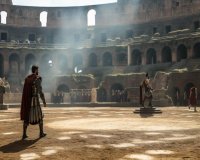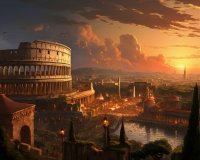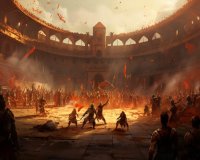Gladiators in Rome: Must-See Attractions
Rome, the eternal city, is a treasure trove of historical wonders, and among its most intriguing attractions are the remnants of the ancient gladiatorial arenas. These iconic structures stand as a testament to the grandeur and brutality of the Roman Empire, offering visitors a glimpse into the lives of gladiators and the spectacles that once enthralled the citizens of Rome.
One of the most renowned sites associated with gladiators is the Colosseum, also known as the Flavian Amphitheatre. This colossal structure, an engineering marvel of its time, could hold up to 80,000 spectators who gathered to witness epic battles between gladiators, exotic animal hunts, and other public spectacles. As you step inside the Colosseum, you can almost hear the echoes of the past, imagining the roars of the crowd and the clashing of swords.
Adjacent to the Colosseum lies the Roman Forum, the heart of ancient Rome, where political, religious, and commercial activities converged. Gladiators often paraded through the Forum, displaying their strength and prowess to the public. Exploring the ruins of temples, basilicas, and arches in the Forum allows you to immerse yourself in the world where gladiators once walked.
Another significant gladiatorial arena in Rome is the Roman Amphitheatre of Capua, located in the nearby city of Santa Maria Capua Vetere. This amphitheatre, believed to be the prototype for the Colosseum, offers a unique perspective on the gladiatorial games. Visitors can wander through the underground chambers where gladiators and animals were held before their battles, gaining insights into the behind-the-scenes preparations for these deadly contests.
For a more intimate experience with gladiatorial history, the Ludus Magnus, the largest gladiatorial training school in Rome, provides a fascinating glimpse into the training regimen of gladiators. Situated near the Colosseum, this ancient training ground features well-preserved remains of training rooms, living quarters, and practice arenas. Walking through these ruins, you can almost feel the dedication and discipline that defined the lives of gladiators.
If you are fascinated by the gladiatorial games, a visit to the Gladiator Museum is a must. Located near the Roman Forum, this museum houses a remarkable collection of artifacts, including gladiatorial weapons, armor, and artwork depicting scenes from the arena. The museum offers valuable insights into the life and equipment of gladiators, allowing you to appreciate the skill and craftsmanship involved in their craft.
In conclusion, exploring the gladiatorial attractions in Rome is a captivating journey into the past, offering a deeper understanding of the ancient world and the lives of those who fought in the arena. From the grandeur of the Colosseum to the intimate spaces of gladiatorial training grounds, these sites provide a vivid picture of Rome's gladiatorial legacy, making them essential stops for history enthusiasts and curious travelers alike.
Rome: Colosseum, Arena, Roman Forum, and Palatine Hill Tour
Take a journey through Roman history by exploring the iconic sites of Rome, including skip-the-line access to the Colosseum, the reconstructed Arena Floor, and the ruins of Palatine Hill and Roman Forum.
About this activity
Embark on a 3-hour tour with live guided commentary in English. Highlights include the Porta Libertina, the Port Triumphalis, and a bird’s eye view into the hypogeum or underground. Step onto the reconstructed arena floor for a 360-degree view, explore the trap door used for bringing animals or slaves, and get a close look at the complex underground systems of the Hypogeum.
Includes
- Skip-the-line tickets for Colosseo & Arena & Roman Forum & Palatin Hill
- Live guided tour with headsets for clear communication
- Visit of the first and second floor of Colosseo and Arena and Roman Forum and Palatin Hill
Not suitable for
Wheelchair users
Meeting point
Meet your guide with the sign Eternal City Tours.
Important information
Bring Passport or ID card, and wear comfortable shoes. Provide ages and full names for everyone in your group.
Price
From $99.17 per person
Customer reviews
Overall rating: 2.8/5 based on 5 reviews.
The World of Roman Gladiators
When one thinks of ancient Rome, images of grandeur, conquest, and innovation often come to mind. Yet, one aspect of Roman society that both fascinated and shocked people throughout the centuries was the world of Roman gladiators.
Gladiators were the professional combatants of ancient Rome, and their fights were the ultimate source of entertainment for the masses. Let's delve into this captivating arena of Roman history.
The Origins of Gladiatorial Combat
Gladiatorial combat had its roots in ancient Roman funeral practices. The first recorded gladiatorial games, or "munera," date back to the 3rd century BCE. These games were initially held to honor the deceased and to appease the spirits of the dead. Over time, they evolved into grand public spectacles.
The Gladiators
Gladiators came from diverse backgrounds. They could be slaves, prisoners of war, criminals, or free volunteers seeking fame and fortune. Each type of gladiator had a unique fighting style and weaponry, such as the heavily armored secutores, the nimble retiarii, and the fearsome murmillos.
The Colosseum: Gladiatorial Grandeur
The Colosseum in Rome stands as an iconic symbol of the gladiatorial games. This colossal amphitheater could hold up to 80,000 spectators and hosted epic battles between gladiators, exotic animal hunts, and naval reenactments.
These events were not merely about violence. They were also a reflection of Roman society's values, the power of the emperor, and the relationship between the rulers and the ruled.
Life and Death in the Arena
The life of a gladiator was a precarious one. They faced the constant threat of injury or death, but successful gladiators could earn riches, fame, and even freedom. The phrase "Ave, Imperator, morituri te salutant" (Hail, Emperor, those who are about to die salute you) became a famous motto of gladiators before their battles.
The End of Gladiatorial Combat
As the Roman Empire declined, so did the popularity of gladiatorial combat. The brutal and extravagant nature of these games began to be seen as a symbol of excess and decadence. In 404 CE, the Christian Emperor Honorius officially banned gladiatorial contests.
Legacy
The legacy of Roman gladiators endures through history and popular culture. These warriors have been featured in countless books, movies, and TV shows. Their stories continue to captivate audiences worldwide.
In conclusion, the world of Roman gladiators is a fascinating and complex aspect of ancient Roman culture. It reflects the values, politics, and entertainment of the time, and its influence can still be felt today in various forms of media and entertainment.
Rome: Gladiator Show and Museum Experience
Transport yourself back in time with a captivating demonstration of a gladiator fight at the Gladiators' headquarters, just 3.5 km from the Colosseum. This unique event, presented by Gruppo Storico Romano, unfolds in a specially equipped arena with music, lights, and visual effects, offering an immersive dive into Roman history.
Witness a spectacular Gladiators Fight, Ancient Dances, Vestals Rites, and Pantomime, all orchestrated by historical reenactors wielding real weapons and armor. Capture the essence of ancient Rome and take all the pictures you desire during this hour and a half-long event.
Don't miss the chance to explore the "Museo storico - didattico del legionario romano" and enjoy a cocktail in the Armory of the Legion before the event concludes around 22:00. This mesmerizing show runs every Friday from May 13 to September 16, 2022.
Highlights:
- Ancient Atmosphere: Immerse yourself in the authentic setting of Gladiators' headquarters.
- Real Roman Life: Experience a realistic portrayal of ancient Roman life through the reenacted events.
- Originality: Enjoy a one-of-a-kind show featuring Gladiators Fight, Ancient Dances, Vestals Rites, and Pantomime.
Includes: Museum visit and the mesmerizing Gladiator Show.
Meeting Point: Look for Rome Gladiator School - 'Gruppo Storico Romano'.
Price: From $26.38 per person. Reserve now & pay later to secure your spot without any upfront payment.
Customer Reviews: Rated 4.4/5 based on 76 reviews. Visitors praise the professional preparation of the show and recommend it for both adults and children.
The Significance of Gladiator Fights in Roman Culture
The ancient city of Rome, often referred to as the "Eternal City," holds a prominent place in the annals of history. One of the most intriguing aspects of Roman culture was the spectacle of gladiator fights. These brutal and captivating contests were a cornerstone of Roman entertainment, bearing a significance that extended beyond mere bloodsport.
The Origins of Gladiator Games
The origins of gladiator games in Rome can be traced back to the early days of the Republic. These events began as funeral games, held to honor deceased individuals. Over time, they evolved into grand spectacles, a fusion of bloodshed and entertainment.
Gladiators were typically slaves, prisoners of war, or condemned criminals, and they were trained in specialized combat schools known as "ludi." These fighters would be pitted against one another or wild animals, often in massive amphitheaters like the famous Colosseum. The brutal nature of these contests is undeniable, but they served several vital functions in Roman society.
Social Control and Political Power
Gladiator games had a significant impact on Roman society and politics. They were used as a means of social control, a way for the ruling elite to distract the masses from pressing issues and to maintain their support. By providing free admission to these events, the Roman authorities ensured that the citizens had a constant source of entertainment.
Furthermore, these contests were an essential tool for emperors and politicians to gain popularity and maintain power. The lavish nature of the games, with extravagant feasts, music, and pageantry, elevated the status of the hosts in the eyes of the public. A generous benefactor of gladiator games could garner the loyalty of the people and solidify their rule.
Symbolism and Ritual
Gladiator contests were laden with symbolism and ritual. Each bout had its own narrative, with the combatants often representing various archetypes, such as the valiant hero or the defeated underdog. These narratives could mirror societal values and serve as allegories for life's struggles.
The combat itself was deeply ritualistic. The gladiators would enter the arena to the cheers of the crowd, often with elaborate introductions. The combatants' weapons and armor were carefully chosen to evoke specific cultural or historical references, reinforcing the connection between the fight and the audience's collective identity.
Legacy and Decline
The significance of gladiator fights extended far beyond the Roman era. They left an indelible mark on popular culture, inspiring countless works of art, literature, and film. Even today, the image of the gladiator remains a symbol of strength and resilience.
However, as Rome transitioned from a Republic to an Empire, and as the influence of Christianity grew, the popularity of gladiator games began to wane. The Emperor Constantine, a convert to Christianity, took steps to abolish these violent contests in the early 4th century, marking the beginning of the end for gladiator combat in Roman culture.
In conclusion, the significance of gladiator fights in Roman culture cannot be overstated. They served as a complex and multifaceted aspect of society, influencing not only entertainment but also politics, symbolism, and ritual. These games were a reflection of the values and priorities of the time, and their legacy endures as a testament to the grandeur and brutality of ancient Rome.




 Rhythms of Rome: The Gladiator Show & Museum Experience
Rhythms of Rome: The Gladiator Show & Museum Experience
 Legacy of Ancient Rome: From Gladiators to Emperors
Legacy of Ancient Rome: From Gladiators to Emperors
 Roman Gladiatorial School: A 2-Hour Insight
Roman Gladiatorial School: A 2-Hour Insight